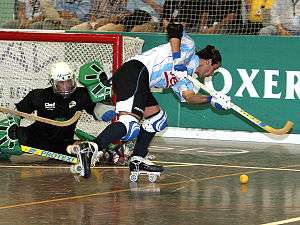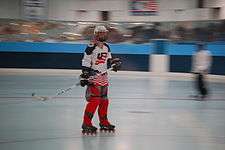Roller hockey
Roller hockey is a form of hockey played on a dry surface using wheeled skates.[1] Most professional inline hockey games take place on an indoor or outdoor sport court (a type of plastic interlinking tiles used to create a skating surface). Otherwise, any dry surface can be used to host a game, typically a roller rink, macadam, or cement. The term "Roller hockey" is often used interchangeably to refer to three variant forms chiefly differentiated by the equipment used. There is traditional "Roller hockey" (Quad hockey, Rink hockey), played with quad skates and a ball (without contact), "Inline hockey", played with inline skates and puck (without contact) and "Skater hockey", played with quad skates or inline skates and plastic ball (with contact like ice hockey). Combined, roller hockey is played in nearly 60 countries worldwide. [2][3]
Comparison with quad hockey and inline hockey
Roller hockey is played on both quad skates and inline skates, have different rules and equipment, and involve different types of skating but share the category and name of roller hockey. Roller hockey (quad) is played using traditional quad roller skates, affording greater maneuverability to the player - this results in games filled with fancy footwork, tight maneuvering, and is more similar to football or basketball. The stick is more or less the same as in bandy and shinty. Roller hockey (inline) bears close resemblance to ice hockey and is played on inline skates, uses an ice hockey stick and includes a lot of fast "racing back and forth" action. Inline hockey goalies use a glove called a catcher to catch shots made on goal, and a flat, usually square, mitt called a blocker which is used to deflect shots on goal. The Quad hockey goalie uses a flat batting glove that provides rebound characteristics when blocking a shot on goal.
Quad hockey

Quad hockey is a variation of roller hockey. Roller hockey is the overarching name for a rollersport that has existed long before inline skates were "re-invented" in the 70s (They were actually invented before quads, in the 1760s). Roller hockey has been played on quad skates, in sixty countries worldwide and so has many names worldwide. Sometimes the sport is called Quad Hockey, Hóquei em Patins (PT), Rolhockey (NL), Rollhockey (DE), International Style Ball hockey, Rink hockey (FR), Hockey Su Pista (IT), Hoquei sobre Patins (CA), Hockey sobre Patines (ES), Rulleskøjtehockey (DA), Rullbandy (S), Rulluisuhoki (ET) and Hardball hockey (US), depending on which region of the world it is played. Roller hockey was a demonstration rollersport in the 1992 Summer Olympics in Barcelona.
Inline hockey

Inline hockey is a variation of roller hockey very similar to ice hockey, from which it is derived.[4] It is referred to by many names worldwide, including Ball Hockey, Inline hockey, Roller hockey, Longstick hockey, Deck hockey, Road hockey, Street hockey and Skater hockey depending on which region of the world in which it is played.
Like ice hockey, Inline hockey is a contact sport therefore body checking isn't penalized. It is similar to ice hockey in that teamwork, skill and aggressiveness are needed. Excepting the use of inline roller skates in lieu of ice skates, the equipment of inline roller hockey is similar to that of ice hockey.
The game is played by two teams, consisting of four skaters and one goalie, on a dry rink divided into two halves by a center line, with one net at each end of the rink. When played more informally, the game often takes place on a smooth asphalt surface outdoors. The game is played in three 15-minute periods or if it is higher standard it's played 20-minutes in each of the three periods. The game rules differ from ice hockey in a few simple ways: there is no icing and it is played in a 4 on 4 player format instead of 5 on 5.
Generally speaking, only competitive level Inline hockey is strictly bound by the governing body's rules. Recreational hockey leagues may make modifications to certain aspects of the rules to suit local requirements (size of rink, length of periods and penalties). Roller hockey is a growing sport in Britain with teams cropping up all over the country. The fact that it can be played on any dry surface means that you can play it in almost any leisure center.
Tournaments and competitive Roller Hockey
Most competitive youth hockey teams play in tournaments. The tournaments vary depending on location, but a typical bracket system is usually used. Teams travel to different locations around their state, sometimes even going out of state. There are inner state tournaments and out of state tournaments. There are even national tournaments competitive teams compete for.
The World Skate is the international association that organize the biggest roller hockey world championship (which is a part of the World Roller Games). Over twenty national teams participate in these two events.
There are other tournaments located in the U.S but played by players all around the world. Narch and Statewars are two Nationwide tournaments of every skill level and age group.
In skater hockey, the sport is governed in Europe by the International Inline-Skater hockey Federation.
Roller hockey brands
Many of the same brands that make ice hockey equipment also make roller hockey skates including Bauer, Easton, Mission, Tron and many more. There are also some brands that specialize in roller hockey like el Leon de Oro (Spain), Tour, Alkali, Revision and Mission (but they make some ice hockey equipment also). Other rink hockey brands include Reno, TVD, Meneghini, Proskate and Azemad.
See also
External links
References
- ↑ "Tribute for a Roller Hockey Warrior Who Broke the Color Barrier". The New York Times. 4 May 2015. Retrieved 9 December 2016.
- ↑ "In-Line Hockey: Still Rolling, but Not on a Roll". The New York Times. 27 February 2011. Retrieved 9 December 2016.
- ↑ Conover, Kirsten A. (29 April 1991). "'Bladers' Skate Their Way Into Hot Sports Trend". Retrieved 9 December 2016 – via Christian Science Monitor.
- ↑ Rinehart, Robert E. (1 January 2013). "Inline Skating in Contemporary Sport: An Examination of Its Growth and Development". Paul Cowan. Retrieved 11 December 2016 – via Google Books.